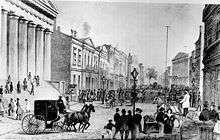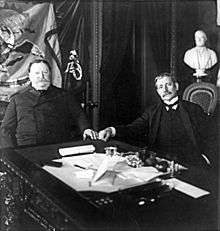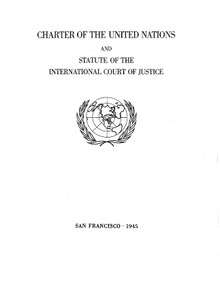Grenville Clark
Grenville Clark (November 5, 1882 – January 13, 1967) was a 20th-century American Wall Street lawyer, co-founder of Root Clark & Bird (later Dewey Ballantine, then Dewey & LeBoeuf), member of the Harvard Corporation, co-author of the book World Peace Through World Law, and nominee for Nobel Peace Prize.[1][2][3]
Grenville Clark | |
|---|---|
| Born | November 5, 1882 |
| Died | January 13, 1967 (aged 84) |
| Nationality | American |
| Alma mater | Harvard Law School |
| Years active | 1909–1945 (law office) |
| Employer | Root Clark & Bird (later Dewey Ballantine, Dewey & LeBoeuf) |
| Known for | Plattsburgh Citizens' Military Training Camp |
Notable work | World Peace Through World Law with Louis B. Sohn (1958) |
| Movement | World Federalist Movement |
| Board member of | Harvard Corporation |
| Spouse(s) | Fanny Pickman Dwight |
| Children | Grenville Clark Jr., Mary Dwight Clark (Thoron), Louisa H. Clark (Spencer) |
| Relatives | LeGrand Bouton Cannon (maternal grandfather) |
The National Historic Register (US DOI, National Park Services) has called Clark an "international lawyer and legal architect of world organizations," who was "active in world peace efforts and an advisor in governmental affairs." Further, he was a "drafter of the United Nations Charter, author of A Plan for Peace and co-author of the acclaimed World Peace Through World Law. He was an advisor to four United States Presidents, founder of the Military Training Camp Association (1917) and leader of the Plattsburg movement, and author of the Selective Service Act of 1940. Clark organized the two Dublin Peace Conferences, held at the Morse Farm in 1945 and 1965, out of which grew the United World Federalists."[4]
Background

Grenville Clark was born on November 5, 1882, in New York City. His parents were Louis Crawford Clark and Marian de Forest Cannon. His father attended Harvard University and worked all his life at his father's banking firm (Clark, Dodge & Company) on Wall Street. His mother was the granddaughter of banker Colonel LeGrand Bouton Cannon (1815–1906); the family lived in her grandfather's mansion in Manhattan. He had three brothers and a sister.[1][3]
In 1903, he entered Harvard Law School, where he met classmate Felix Frankfurter. "The two became close friend and sometimes conspirators on public service projects throughout their lives." The childless Frankfurter was unofficial "uncle" to Clark's children. When Frankfurter retired from the United States Supreme Court, Clark took care of financial matters like medical bills.[1][3]
Career
Law practice

In 1909, Harvard Law School graduates Clark, Francis W. Bird, and Elihu Root, Jr. (son of Elihu Root, Sr., founded the law firm of Root, Clark & Bird. An early member and star of the firm was Henry Friendly, recommended by Frankfurter and following a one-year clerkship with Supreme Court Justice Louis Brandeis. In 1913, the firm merged with Buckner & Howland to form Root, Clark, Buckner & Howland. In 1919, Arthur A. Ballantine, the Internal Revenue Service's first solicitor, joined. Ballantine and Buckner ran the firm throughout the 1920s and 1930s. During the Great Depression, the firm flourished by moving away from its traditional focus on litigation and began to focus on bankruptcy and reorganizations and New Deal regulations. The firm also built up a corporate practice, serving clients such as AT&T and Standard Oil. Overall, the firm expanded from eight (8) to 74 associates and opened a second office in Washington, D.C. Both Henry Friendly and John Marshall Harlan II worked at the firm during this period. In 1931, the offices of Root, Clark, Buckner & Ballantine were t 31 Nassau Street (Manhattan) in Manhattan. (The firm later merged to form Dewey Ballantine, currently Dewey & LeBoeuf.)[1][3][5]
During World War I, Clark helped establish the Citizens' Military Training Camp at Plattsburgh, New York and other forms of military preparedness.[3]
In 1931, Clark was elected one of the five fellows (plus Harvard University president and treasurer) of the Harvard Corporation, a body overseeing the university since 1650. In 1933, he was instrumental in having James Bryant Conant elected president of Harvard University; the two become close friends. In 1950, he retired from the Corporation, for which he received an honorary doctoral degree in Law.[1]
In the 1930s, Clark founded the American Bar Association’s Civil Liberties Committee, claiming that support for civil liberties was a conservative cause aimed at resisting government excess. In 1933, he helped draft Economy Act of 1933. He joined in drafting committee amicus briefs to the Supreme Court in defense of free speech and, in the flag salute cases, asserting the right of individuals on conscientious grounds not to salute the flag.[3]
In 1940, as a member of the Military Training Camps Association, a World War I veterans' group, Clark authored the Burke-Wadsworth Bill. During World War II, Clark again help in military preparedness, including the drafting of the Selective Training and Service Act of 1940. From 1940 to 1945, he served as confidential counsel to Secretary of War Henry L. Stimson.[3]
In 1945, Clark retired from the law firm.[6]
World peace

On October 16, 1945, before the UN Charter entered into force, Clark, retired U.S. Supreme Court Justice Owen J. Roberts, former New Hampshire Governor Robert P. Bass, and more than forty others held the "Dublin Conference" in Dublin, New Hampshire. There they passed a "Dublin Declaration," which, judging the UN Charter inadequate to preserve peace, proposed transformation of the U.N. General Assembly into a world legislature. It stated, "Such a government should be based upon a constitution under which all peoples and nations will participate upon a basis of balanced representation which will take account of natural and industrial resources and other factors as well as population. It cannot be based on treaties...in which the states... act and vote as states".[1][7][8] It called for "limited but definite and adequate power for the prevention of war."[9]
In 1965, Clark held a second "Dublin Conference," which made a second declaration. About that time, he founded the "Grenville Clark Institute for World Law."[10] In 1967, its committee members comprised: Thomas H. Mahony, Douglas Arant, Mrs. Mildred R. Blake, Mrs. William W. Bray, Henry B. Cabot, Grenville Clark Jr., Randolph P. Compton, Rev. Robert Drinan SJ, H. Ferry, Hudson Hoagland, Harry B. Hollins, Walter J. Leonard, Mrs. Edward W. McVitty, J. A. Migel, Gerard Piel, Stanley K. Platt, Gabriel Reiner, Robert H. Reno, William G. Saltonstall, Louis B. Sohn, C. Maxwell Stanley, James P. Warburg, and Abraham Wilson. Its executive committee comprised: Hudson Hoagland, George C. Holt, Thomas H. Mahony, Robert H. Reno. Its executive director was George C. Holt. The group's bsse was in Woodstock, Connecticut.[11]
Clark and other participants in the Dublin Conference became active in the United World Federalists (UWF) and the global World Federalist Movement.[12] UWF enjoyed some success in the postwar period, as 23 state legislatures passed bills supporting the organization’s goals, but McCarthyism prompted many prominent members to resign lest Senator Joseph McCarthy ruin their careers.[13] In the United States, internationalism came to be associated with communism.[14]
After formation of the United Nations, Clark supported the World Federalist Movement. Clark and Harvard Law School professor Louis B. Sohn drafted amendments to the United Nations Charter. Their amendments sought to transf the United Nations into a true world federal government. They limited its primary powers to suppression of war, a radical redirection that would have required global disarmament and formation of a world police force. They published their writings in World Peace Through World Law, published in 1958.[3]
Personal and death

On November 27, 1909, Clark married Fanny Pickman Dwight. They had four children: Eleanor Clark (who died in childhood), Grenville Clark Jr., Mary Dwight Clark (Thoron), and Louisa H. Clark (Spencer).[1][3]
He was a personal friend of Teddy Roosevelt.[3]
As a member of the Harvard Corporation, Clark was a friend of William L. Marbury, Jr., from whom he received correspondence during the Hiss Case in 1948. (Hiss was acting UN secretary general at the UN's first-ever session in 1945.)[15] In 1949, Clark made a donation (a "very moderate check I sent toward legal expenses") to the Hiss defense fund, for which Hiss thanked him, followed by a letter from Clark to Hiss in which he stated that he had "no personal acquaintance with you."[16]
Clark died on January 13, 1967, at his home in Dublin, New Hampshire.[3]
Awards
Between 1959 and 1964, Clark received several nominations for the Nobel Peace Prize[2]
Works
- Spendthrift Trusts in New York: Needed Reforms in the Law (1914)[17]
- Jubilee Law Lectures, 1889-1939 with Roscoe Pound, Daniel J. Lyne, Hector David Castro, and John J. Burns (1939)[18]
- A Memorandum: With Regard to a New Effort to Organize Peace and Containing a Proposal for a "Federation of Free Peoples" (1939)[19]
- Citizens Committee for a National War Service Act: Effort for a national service law in World War II, 1942-1945; report to the National Council of the Citizens Committee for a National War Service Act, by Grenville Clark, chairman, and Arthur L. Williston, secretary (1947)
- Freedom at Harvard, 1949 (1949)[20]
- Plan for Peace (1950)[21][22]
- Peace through disarmament and charter revision (1953)[23][24]
- "A Digest of Peace through Disarmament and Charter Revision" (1953)[25]
- World Peace Through World Law: Two Alternative Plans with Louis B. Sohn (1958)[26] (1960)[27] (1966)[28]
- The Need for Total Disarmament Under Enforceable World Law (1964)[29]
- A Proposed Treaty Establishing a World Disarmament and World Development Organization (1965)[30]
- Roundtable III: Summary of Convocation (1965) [sound recording][31]
Legacy
In 1937, Edgar Snow dedicated his book Red Star Over China to Clark, writing: "To Grenville Clark who was taller than his time 'Laid sweet in his grave, the hope of humanity not yet subjugate in him.' – Emerson."[32]
The 1958 book World Peace through World Law remains Clark's lasting legacy.
In 1969, Clark donated the Clark Botanic Garden to the Brooklyn Botanic Garden.[33]
In 1985, the US Postal Service honored Clark posthumously with a 39¢ Great Americans series (1980-2000) postage stamp.[34]
See also
- World Peace Through World Law
- World Federalist Movement
- Louis B. Sohn
- Emory Buckner
- Harvard Corporation
- James Bryant Conant
- William L. Marbury, Jr.
- Alger Hiss
References
- Hill, Nancy Peterson (2014). A Very Private Public Citizen: The Life of Grenville Clark. University of Missouri Press. pp. 12–13 (parents), 20–21 (Frankfurter), 27–28 (Friendly), 35 (marriage), 85 (Corporation), 86 (Conant), 162 (Dublin Conference), 185–186 (Sohn), 189 (honorary degree), 214–215 (Sohn). ISBN 9780826273192. Retrieved 28 September 2017.
- "Nomination Database on Grenville Clark". Nobel Prize. Retrieved 28 September 2017.
- "Grenville Clark papers, 1636-1972". Dartmouth College. Retrieved 28 September 2017.
- "Inventory Nomination Form: Eli Morse Farm AKA Clark/Spencer Property". US DOI - NPS - National Register of Historic Places. 25 February 1983. Retrieved 3 December 2017.
- The American Oxonian. 1931. pp. 256 (office address), 258, 259.
- "Dewey Ballantine LLP History". Funding Universe. Retrieved 4 October 2017.
- Baratta, Joseph Preston (2004). The Politics of World Federation. Preager Publishers. p. 540. ISBN 0-275-98068-5. Retrieved 7 December 2007.
- Roberts, Christopher N. J. (10 November 2014). The Contentious History of the International Bill of Human Rights. Cambridge University Press. pp. 79, 86. ISBN 9781107014633. Retrieved 7 December 2007.
- "S.Doc.107-3 Authority and Rules of Senate Committees, 2001–2002". Government Records.
- "Grenville Clark Fund: Full Finding Aid for the". Dartmouth College. Retrieved December 16, 2017.
- "Declaration of the Second Dublin Conference" (PDF). Grenville Clark Institute for World Law. October 5, 1965. Retrieved December 16, 2017.
- Clifford, J. Garry (2007). Grenville Clark Archived 29 September 2008 at the Wayback Machine. Retrieved 7 December 2007.
- 60 Years of Global Solutions Archived 12 May 2008 at the Wayback Machine, Citizens for Global Solutions. Retrieved 7 December 2007
- Bigman, Stanley K. (1950). "The 'New Internationalism' Under Attack". The Public Opinion Quarterly, Vol. 14, No. 2 (Summer, 1950), pp. 235–61.
- Marbury, Jr., William L. (15 September 1948), (Letter to Grenville Clark), Maryland Historical Society, retrieved 28 September 2017
- Clark, Grenville (31 March 1949). "Folder: 140, Hiss, Alger, 1949". Dartmouth College. Retrieved 28 September 2017.
- Clark, Grenville (1914). Spendthrift Trusts in New York: Needed Reforms in the Law. Bench and Bar Company. Retrieved 4 December 2017.
- Clark, Grenville; Pound, Roscoe; Lyne, Daniel J.; Castro, Hector David; Burns, John J. (1939). Jubilee Law Lectures, 1889-1939. Catholic University of America Press. LCCN 40004616.
- Clark, Grenville (1939). A Memorandum: With Regard to a New Effort to Organize Peace and Containing a Proposal for a "Federation of Free Peoples" in the Form of a Draft (with Explanatory Notes) of a Constitution for the Proposed Federation. Democracy. Retrieved 4 December 2017.
- Clark, Grenville; Conant, James Bryant (1953). Peace through disarmament and charter revision. Retrieved 4 December 2017.
- Clark, Grenville (1950). Plan for Peace. Harper. Retrieved 4 December 2017.
- Plan for Peace. Kirkus Review. 1950. Retrieved 4 December 2017.
- Clark, Grenville; Sohn, Louis B. (1953). Peace through disarmament and charter revision. ?. LCCN 56003572.
- Clark, Grenville (1953). Peace through disarmament and charter revision. ?. Retrieved 4 December 2017.
- Clark, Grenville; Sohn, Louis B. (1953). A digest of peace through disarmament and Charter revision: detailed proposals for revision of the United Nations Charter. Robert H. Reno. LCCN 58007246.
- Clark, Grenville; Sohn, Louis B. (1958). World Peace Through World Law. Harvard University Press. LCCN 58007246.
- Clark, Grenville; Sohn, Louis B. (1960). World Peace Through World Law. Harvard University Press. LCCN 60011741.
- Clark, Grenville; Sohn, Louis B. (1966). World Peace Through World Law: Two Alternative Plans. Harvard University Press. LCCN 66021198.
- Clark, Grenville (1964). The Need for Total Disarmament Under Enforceable World Law. Current History. Retrieved 4 December 2017.
- Clark, Grenville (1965). A Proposed Treaty Establishing a World Disarmament and World Development Organization. Rumford Press. Retrieved 4 December 2017.
- Clark, Grenville; Luce, Henry Robinson; Frank, Jerome; Cousins, Norman; Pell, Claiborne; Burdick, Eugene; Piel, Gerard; Allen, Steve (1965). Roundtable III: summary of convocation. Center for the Study of Democratic Institutions. LCCN 40004616.
- Snow, Edgar (1937). Red Star Over China. Random House. ISBN 9780802196101. Retrieved 18 November 2017.
- "The Mary Cole Mountford Story" (PDF). North Hempstead New York. Retrieved 28 September 2017.
- Sine, Richard L. (17 March 1985). "Stamps: Higher Rates Create a Flurry of New Issues". New York Times. Retrieved 18 November 2017.
Further reading
- Branch, John W. (1952). 1955, year of decision; a survey of the Clark proposals for revising the United Nations Charter. Institute for International Government. LCCN 53002411.
- Norman Cousins; J. Garry Cliffords, eds. (1975). Memoirs of a Man by Grenville Clark. W. W. Norton.
- Dunne, Gerald T. (1986). Grenville Clark: Public Citizen. Farrar, Straus, Giroux.
- Hill, Nancy Peterson (2014). A Very Private Public Citizen: The Life of Grenville Clark. University of Missouri Press.
- Keim, Albert N. The CPS Story, p. 18, Good Books, 1990. ISBN 1-56148-002-9
External links
- The Papers of Grenville Clark at Dartmouth College Library